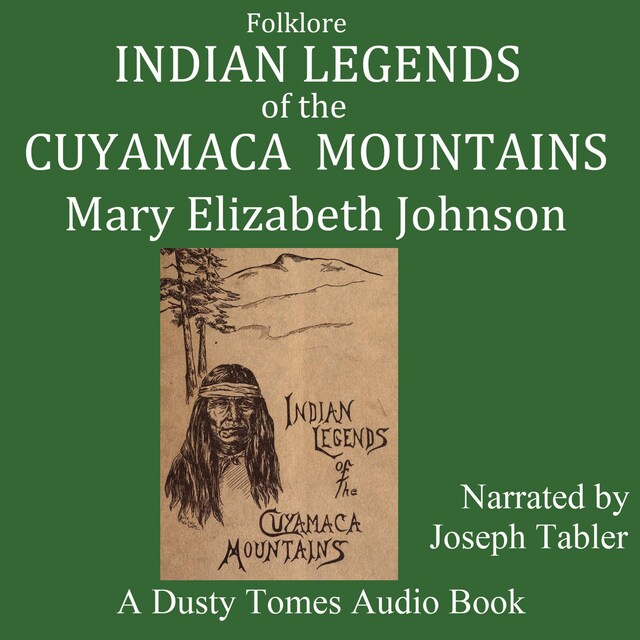
Indian Legends of the Cuyamaca Mountains
Tietoa kirjasta
A Dusty Tomes Audio BookIn Cooperation with Spoken Realms
Indian Legends of the Cuyamaca Mountains by Mary Elizabeth Johnson. Published in 1914 by Mary Elizabeth Johnson.
Narrated by Joseph Tabler. This book is in the public domain. It is read ‘as written.'Audio copyright 2024
Contents of the booklet:
ForewordHilsh Ki’e—Pine TreeHuts-tah’ Ta-mil ‘tah—Hanging HeadAh-ha’ Wi Ah-ha’—Water Colder WaterAh Kwer-rup’—Disease CureHul-ya-oo’ Nimoo-lu ‘kah—Phantom BasketNa-wa-Ti ‘e—Big HouseIn-yar’en Ah-ha’—No Eyes in WaterSeen-u-how ‘How-wak’—Old Woman’s TwinsSeen-u-how ‘Hum-poo’—Old Woman’s WhipKwut ah Lu ‘e-ah—Song DanceAh Kwir’—Red Paint (part missing)
From the Author’s Foreword:Indian lore of the Cuyamaca Mountains and surrounding region in San Diego County, California, abounds in myths and legends handed down from generation to generation by tribal song and squaw-tale. Yet so swiftly has the hand of civilization wiped out the old traditions and customs, that but few Indians remain who remember them, and fewer still are those willing to divulge them. Only when one comes into intimate contact with them is one accorded the privilege and honor of hearing the tales of their ancestors. And it is through the friendship of some of the old-type Indians, that the author has been allowed a glimpse of the inner shrine of their lives.
Cuyamaca is evidently a Spanish corruption of the Indian words Ah-ha’ Kwe-ah-mac’ (Water Beyond), a name used by the Indians, first to designate a location high on the middle mountain, but afterward applied to the entire group.
These mountains had distinctive names also. The one farthest north, they called E-yee’ (Nest), because they believed that a big nest or den was on one of its slopes in which the wild animals disappeared when hunted, thus safely evading pursuit. The middle one, Hal-kwo-kwilsh’ (Tough Strong), gained this title in the battle of the peaks when he proved very formidable. The one known as the Cuyamaca Peak, acquired the name of Poo-kwoo-sqwee’ (Crooked Neck), in the same battle. And before the battle still another peak, Hilsh Ki’e (Pine Tree), belonged to the group, so the Indians say, but now lives far away.
Pronunciation:The Indians accent their words strongly and enunciate with their teeth very nearly closed, which gives their language a rhythmical cadence quite pleasing to the ear.
Dusty Tomes Audio Books are public domain books retrieved from history. If today’s technology had been available when first printed, they would be audio books already. I am grateful for the opportunity to record them now. Read online at archive.org and Hathitrust.org.
Narrator’s note: I read only as written. These old books were once solid sellers for bookmen of their time. I believe they can shed light on their times and ours. Loving obscure and remote literature, they are a distinct pleasure for me to read to you. These turn out to be distant and unknown only so long as they remain unread, or unheard. Aloha.


